 |
Hari Hara I, c. 1336-1356 |
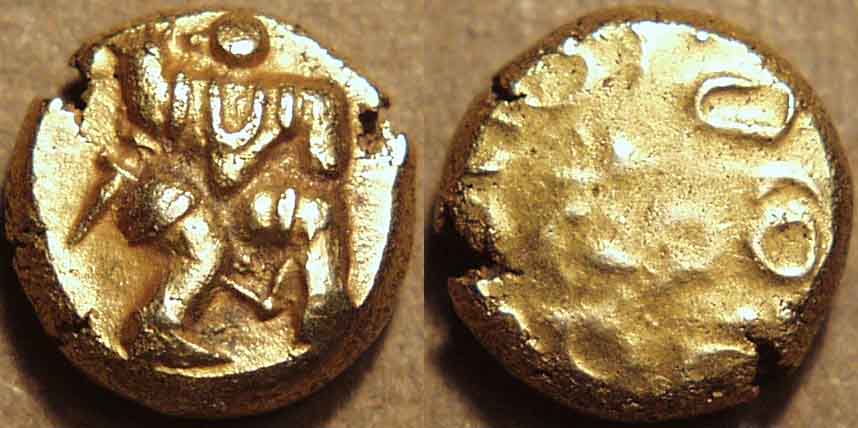
|
Hari Hara I Gold pagoda or gadyana
Weight: 3.38 gm. Diameter: 11-12 mm Die axis: 5 o'clock
Warrior (King?) advancing right, right hand raised, sword at hip
Kannada legend: sri vi / ra hari / hara
Reference: MNI ---, MSI 378
|
 |
Bukka Raya I, c. 1356-1377 |
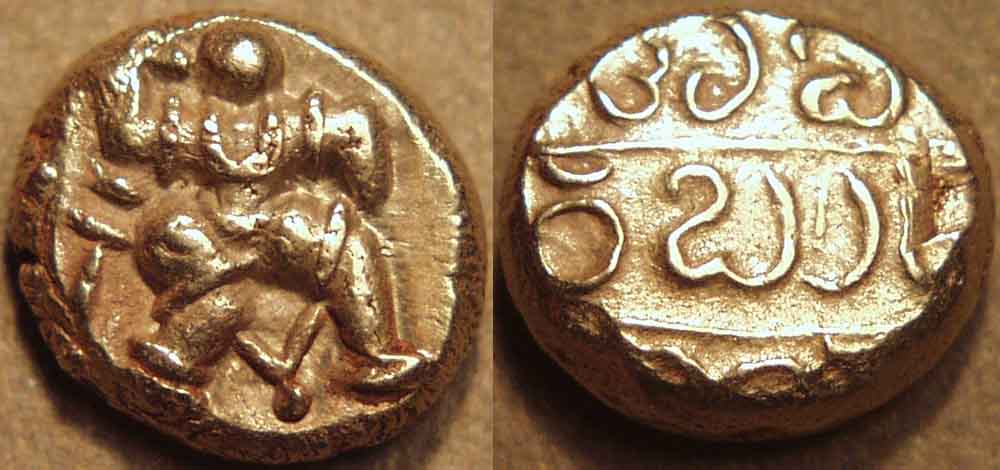
|
Bukka Raya I Gold pagoda or gadyana
Weight: 3.38 gm. Diameter: 11-12 mm Die axis: 5 o'clock
Warrior (King?) advancing right, right hand raised, sword at hip
Kannada legend: sri vi / ra buka / raya

Reference: MNI ---, MSI 392
|
 |
Hari Hara II, c. 1377-1404 |
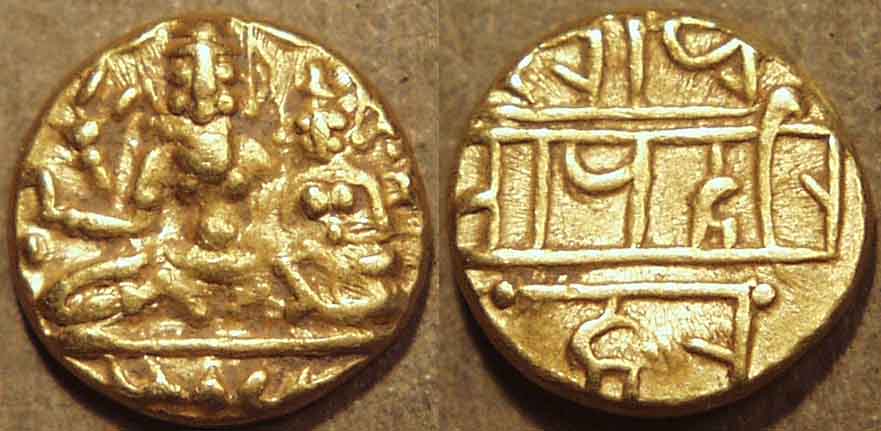
|
Hari Hara II Gold 1/2 pagoda
Weight: 1.68 gm. Diameter: 10 mm Die axis: 5 o'clock
Siva and Parvati seated facing, Siva holding damaru (drum) and trident
Devanagari legend: sri pra / ta pa ha ri / ha ra

Reference: MNI 877, MSI 412
|
 |
The gold coins of Hari Hara II come with either Siva-Parvati (Uma-Mahesvara) on the reverse or Vishnu-Lakshmi (Lakshmi-Narayana).
The Uma-Mahesvara coins in turn come in two varieties, one in which Siva holds a damaru in his right hand (as on this coin, which shows the damaru very clearly)
and one in which he holds an axe (as on the next coin).
|

|
Hari Hara II Gold 1/2 pagoda
Weight: 1.71 gm. Diameter: 9-10 mm Die axis: 5 o'clock
Siva and Parvati seated facing, Siva holding parasu (axe) and mriga or deer
Devanagari legend: sri pra / ta pa ha ri / ha ra
Reference: MNI 877, MSI 412
|
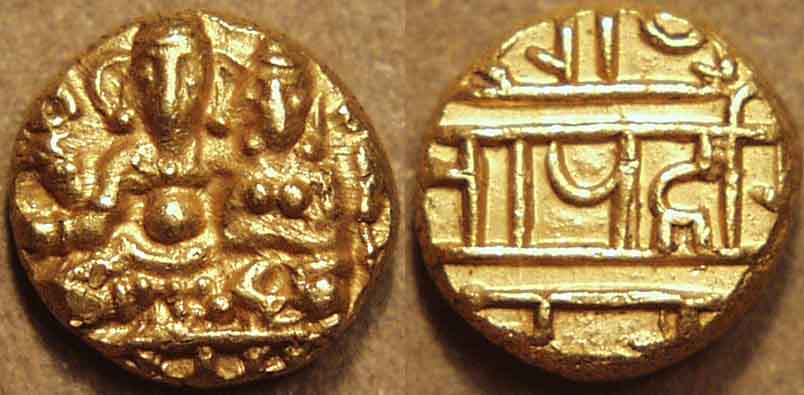
|
Hari Hara II Gold 1/2 pagoda, Lakshmi-Narayan type
Weight: 1.70 gm. Diameter: 9 mm Die axis: 7 o'clock
Vishnu and Lakshmi seated facing, Vishnu holding chakra (wheel) and sankh or conch
Devanagari legend: sri pra / ta pa ha ri / ha ra
Reference: MNI 878, MSI 414
|
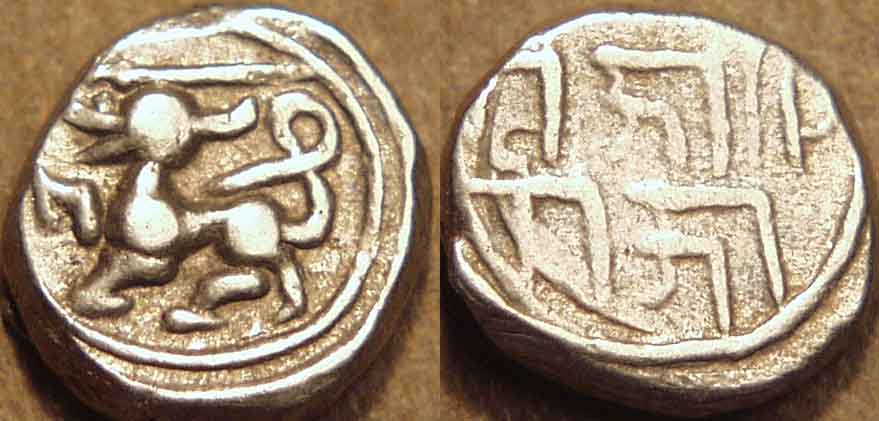
|
Hari Hara I or II Silver 10-rattis
Weight: 1.82 gm. Diameter: 10 mm Die axis: 8 o'clock
Lion left, with right foreleg raised, dagger or sword above, two solid circles around
Within solid circle, Devanagari legend: rajadi / raja, moon and sun above

Reference: MNI ---, MSI 333
|
 |
This coin may have been issued by Hari Hara I.
|
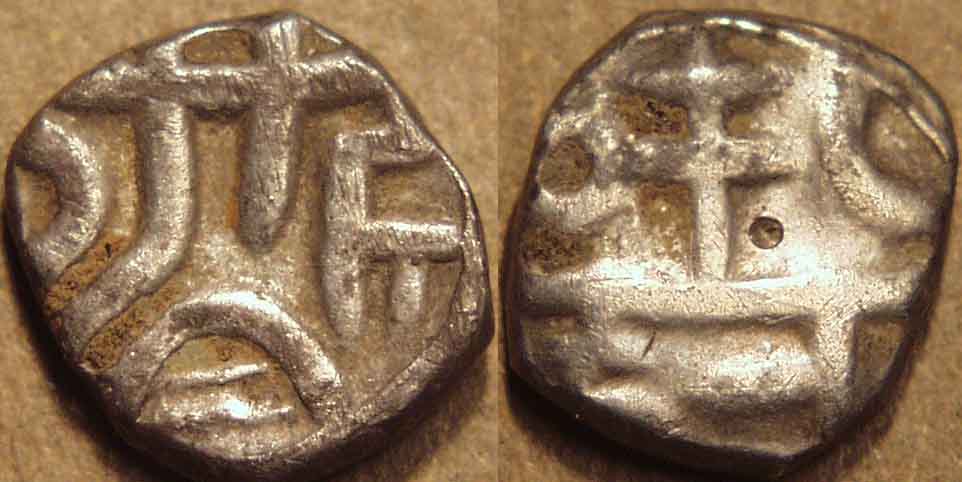
|
Hari Hara II Silver 10-rattis
Weight: 1.80 gm. Diameter: 10-12 mm Die axis: 1 o'clock
Two line Devanagari legend: sri ha / ri
Continuation of Devanagari legend: hara, sun, dagger and moon above
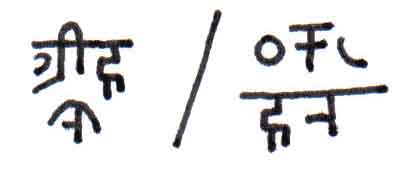
Reference: MNI ---, MSI 331
|
 |
This type had at one time been attributed to Rajadiraja Chola. It was issued in the Goa region.
|

|
Hari Hara II Silver tara (2.5-rattis)
Weight: 0.28 gm. Diameter: 9 mm Die axis: 2 o'clock
Devanagari letter: ha, along with numerals 2+1/2 for the denomination
In a rectangular grid: dagger left, two-line Nagari legend: hari / hara
Reference: MNI ---, MSI 427, Ganesh Karnataka Coins 9.22
|
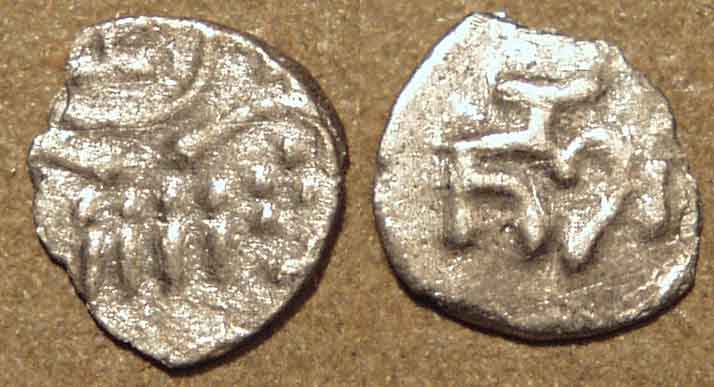
|
Hari Hara II Silver tara (2.5-rattis)
Weight: 0.17 gm. Diameter: 8 mm Die axis: 2 o'clock
Stylized lion (sardula) right, lingam within crescent above
Devanagari letter: ha, along with numerals 2+1/2 for the denomination
Reference: MNI ---, MSI 415, Ganesh Karnataka Coins 8.39
|
 |
Ganesh assigns this coin to the Hoysalas, Mitchiner to Vijayanagar. The obverse features a Hoysala type sardula, seen on the
vira raya coinage, while the reverse seems to have the ha for Hari Hara and the denomination in the style of Hari Hara's coinage. It therefore seems to me more likely
that this is a Vijayanagar issue harking back to the Hoysala origins of the empire.
|
 |
 |
 |
Deva Raya I, c. 1406-1422 and Deva Raya II, c. 1424-1446 |
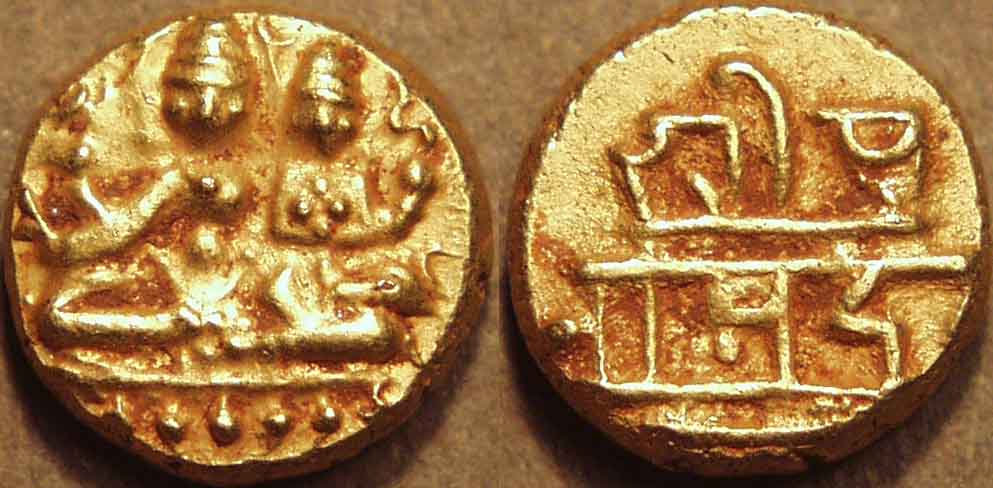
|
Deva Raya I or II Gold pagoda, Uma-Maheshwar type
Weight: 3.43 gm. Diameter: 11 mm Die axis: 2 o'clock
Siva and Parvati seated facing, Siva holding parasu (axe) and mriga or deer
Devanagari legend: sri pra / ta pa de va / ra ya
Reference: MNI ---, MSI --- (unlisted type)
|
 |
Numismatists have so far not been able to satisfactorily separate the coinages of the two kings named Deva Raya.
|
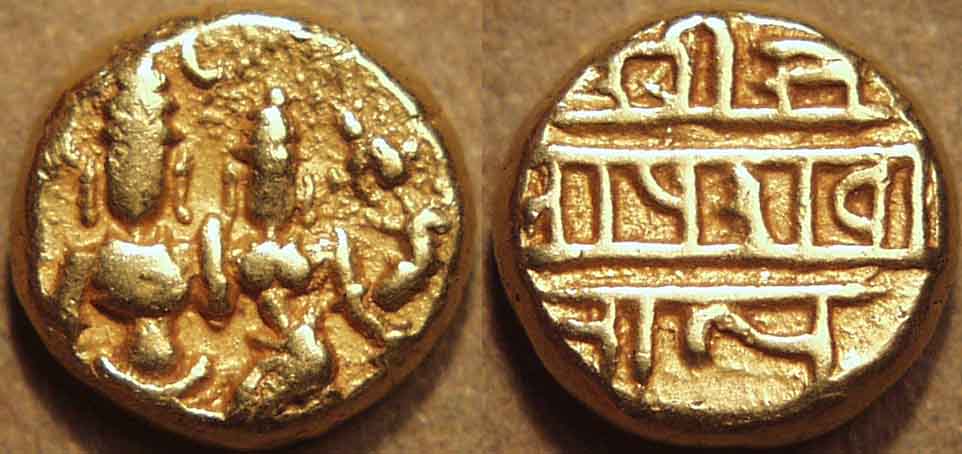
|
Deva Raya I or II Gold pagoda, Lakshmi-Narayana type type
Weight: 3.38 gm. Diameter: 11 mm Die axis: 7 o'clock
Vishnu and Lakshmi seated facing, Vishnu holding chakra (wheel) and sankh or conch
Devanagari legend: sri pra / ta pa de va / ra ya
Reference: MNI ---, MSI --- (unlisted type)
|
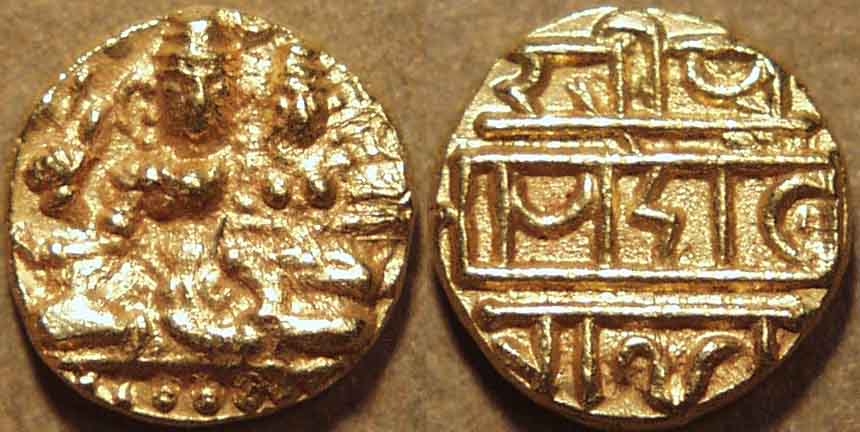
|
Deva Raya I or II Gold 1/2 pagoda
Weight: 1.71 gm. Diameter: 10 mm Die axis: 11 o'clock
Siva and Parvati seated facing, Siva holding damaru (drum) in right hand
Devanagari legend: sri pra / ta pa de va / ra ya
Reference: MNI ---, MSI --- (unlisted type)
|
 |
Mitchiner does not list
a Devaraya half pagoda at all. In this coin, we clearly see one of Siva's key attributes, the damaru , or drum, and the reverse legend is also very clear.
|

|
Deva Raya I or II Gold 1/4 pagoda
Weight: 0.84 gm. Diameter: 8-9 mm Die axis: 4 o'clock
Elephant walking left
Two-liine Devanagari legend: sri de / va ra ya
Reference: MNI 888, MSI 451
|
 |
The quarter pagodas are very rare.
|

|
Deva Raya I or II Silver tara (2.5 rattis)
Weight: 0.16 gm. Diameter: 8 mm Die axis: 7 o'clock
Elephant right
Dagger at left, two-liine Devanagari legend: de va / ra ya
Reference: MNI ---, MSI 464
|
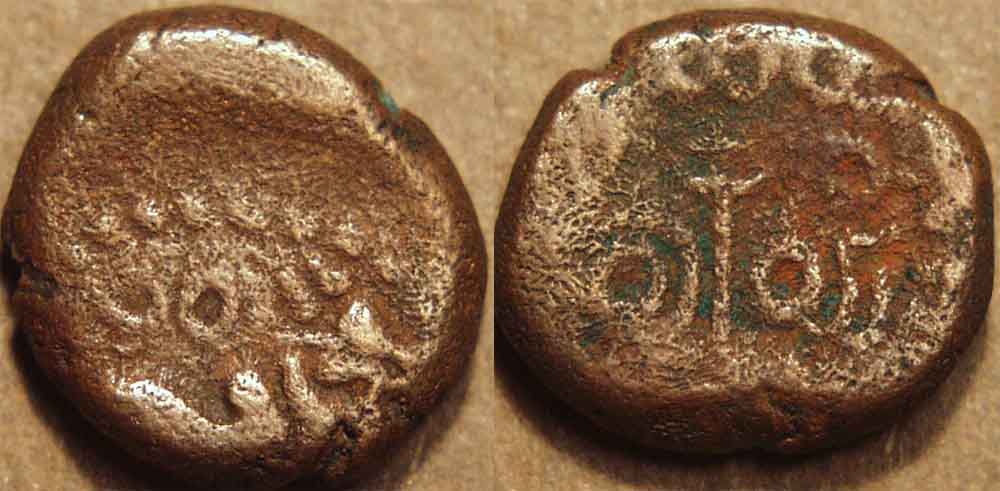
|
Deva Raya II Copper jital, Mulbagal mint
Weight: 3.14 gm. Diameter: 13-14 mm Die axis: 4 o'clock
Humped bull standing right, sun and moon above
Central dagger, flanked by conch and discus, Kannada legend above and below: sri deva / ra ya
Reference: MNI 885, MSI 637
|
 |
Later Kings on Vijayanagar, page 2.
|